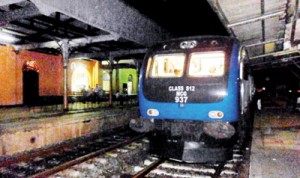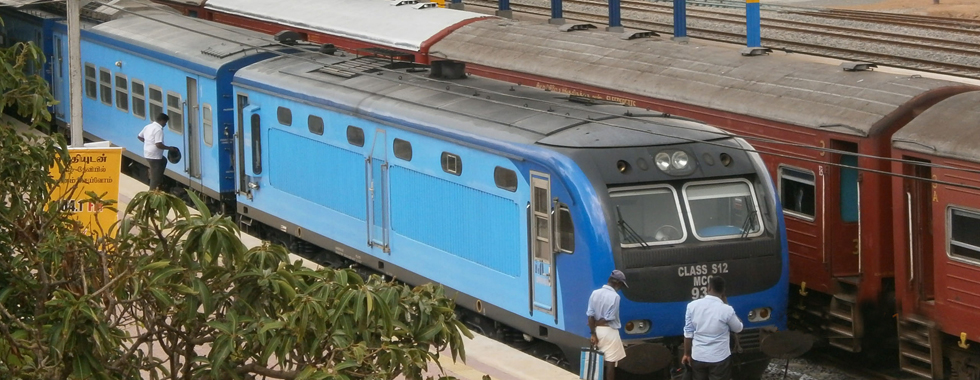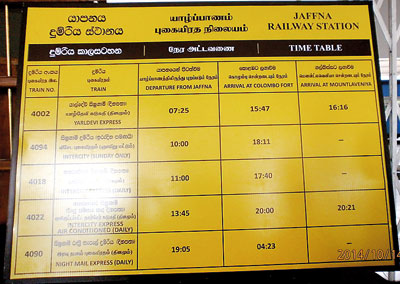On the Yal Devi to Yalpanam
Though all the media hype was on the inaugural Yal Devi, the first train to officially arrive at the Jaffna Railway Station after 24 years on October 13 with President Rajapaksa on board, that special train made its journey only within the peninsula from Pallai to Jaffna.

The train ready to leave Mount Lavinia station and left, at the Jaffna station, photographed from Green Grass hotel
Determined to make the first trip to Jaffna from Colombo, I called Mobitel 365 on the 11th evening but all I got for the 4-minute call that cost Rs 40 was the response that they could not sell me a ticket or confirm the date of the first train to Jaffna. But on the 12th evening, the Colombo Fort railway station confirmed that the first train to Jaffna would leave from Mount Lavinia on the 14th and tickets would go on sale on the 13th.
A First Class AC one-way ticket costs Rs 1400. The departure time printed as 14.45 had been struck off, and over it was written 5.10 from Mount Lavinia. It was all rather confusing. Late on the 13th evening I visited the Mount station and was told it was the 14.45 Intercity to Pallai that had been changed to the morning 5.50. The slower Yal Devi left at 6.30. The announcer was practising the new and longer list of stations.
On the 14th before dawn around 5 a.m., we walked over to the station. It was very quiet. Only a few passengers and a solitary TV crew filming in the engine driver’s compartment, but it never made the evening news that day. The train had only five air-conditioned 1st Class carriages with no 2nd or 3rd Class.
It left on time, and though we expected many to board at Wellawatte that did not happen, possibly since the printed ticket said Colombo Fort,  and most passengers did not know they could get in at Wellawatte. Stopping next only in Bambalapitiya, the train reached Fort by 5.35 where too it became only half-full. To our surprise, it was not expected to stop till it reached Anuradhapura, not even at any major junctions or cities like Kurunegala. Since there is only a single track north of Polgahawela, it was stopped by signalling to let other return trains pass.
and most passengers did not know they could get in at Wellawatte. Stopping next only in Bambalapitiya, the train reached Fort by 5.35 where too it became only half-full. To our surprise, it was not expected to stop till it reached Anuradhapura, not even at any major junctions or cities like Kurunegala. Since there is only a single track north of Polgahawela, it was stopped by signalling to let other return trains pass.
The blue Chinese carriage with 44 reclinable seats in each compartment, has two seats on each side of the aisle that could be rotated so the four seats face each other. With no blinds, try to get seats on the left hand side of the train to avoid being baked in the sun. However seat selection is not offered when buying tickets at the station. The foot rests were too high for comfort and the instructions for use in clearly Chinese English read “While Using Footrest Please Turn Down It”.
In our compartment, six small TV monitors showed the same film and the sound did not work, possibly a blessing in disguise. The ride was a bit

The train time table at Jaffna railway station
bumpy till we reached the new track north of Omanthai, after which the train could go much faster, up to 120 km/h, and the ride was much smoother.
The restaurant car in the middle of the train was not operational and a couple from UK who had travelled in the last train from Jaffna in 1990 had to wait till we reached Anuradhapura to buy some food. There are automated doors at each end and toilets, one bowl and the other squat in each carriage.
We reached Jaffna about 12.30, about 30 minutes later than the scheduled time.
I had last been to Jaffna four years ago, and clearly a lot had changed. We booked in at the Green Grass hotel next to the Railway station, now expanding rapidly, and possibly in the running to manage the restaurant car on the train.
A visit to the Dutch Fort built in 1680 was very interesting. The inner fort has been nicely restored with a grant from the Government of Netherlands and one could appreciate its size and beauty though sadly all of the buildings inside have been destroyed in the war. The Kruys Kerk or Dutch Church was a large pile of rubble, and the Queen’s house had just the walls standing.
The next morning having purchased tickets on the 13.45 return to Colombo, we hired a trishaw to visit some archaeological sites. Trishaws in Jaffna have no meters and fares are at least double those in Colombo. The minimum is Rs.100 and probably when they know you are not local, even the shortest trip is Rs. 200.
The small museum run by the Archaeological Department has been restored. The very large portrait of Queen Victoria which had suffered the ravages of a 30 year war still needed conservation. The coin collection had not been put on display, for lack of security. We next saw the Sangili Topu or the 1519 Arch of King Sankili and visited inside the 15th Century Raja Mandri palace, which was now being made into an archaeological reservation.
Kantharodai or Kadurugoda, a ‘must visit’ site with a recorded history dating back to the 3rd century BCE, about 13 km north, has a collection of around 60 small dagobas, testament to Jaffna’s Buddhist heritage. It is now protected by the army who have built a picket fence around it. The dagobas up to 56 had been numbered.
On the return journey I was able to chat with two railway engineers who spoke of the difficulties of protecting the fittings on the trains, how fire extinguishers and mirrors in the toilets had been stolen by probably drug addicts.
The train reached Colombo Fort around 21 hrs, one hour late. We had to inform those we had overheard saying their destination was Wellawatte, that they needn’t get off but could go on. Clearly, announcements need to be made within the carriages.


